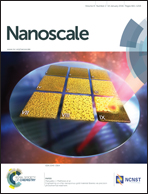Investigation of the surface passivation mechanism through an Ag-doped Al-rich film using a solution process†
Abstract
Electronic recombination loss is an important issue for photovoltaic (PV) devices. While it can be reduced by using a passivating layer, most of the techniques used to prepare passivating layers are either not cost effective or not applicable for device applications. Previously, it was reported that a low cost sol–gel derived Al-rich zinc oxide (ZnO:Al) film serves as an effective passivating layer for p-type silicon but is not effective for n-type silicon. Herein, we studied the elemental composition of the film and the interfacial structure of ZnO:Al:Ag/n-Si using TEM, XPS, FTIR, and SIMS analyses. The XPS analysis revealed that Ag-rich zones randomly formed in the film near the ZnO:Al:Ag//n-Si interface, which induced a positive charge at the interface. The maximal value of the effective minority carrier lifetime (τeff ≈ 1581 μs) is obtained for a wafer using the ZnO:Al:Ag passivating layer with RAg/Zn = 2%. The corresponding limiting surface recombination velocity is ∼16 cm s−1. The FTIR absorption area of Si–H bonds is used to calculate the hydrogen content in the film. The hydrogen content is increased with increasing Ag content up to RAg/Zn = 2% to a maximal value of 3.89 × 1022 atoms per cm3 from 3.03 × 1022 atoms per cm3 for RAg/Zn = 0%. The positive charge induced at the interface may cause band bending, which would produce an electric field that repels the minority charge carriers from the interface to the bulk of n-Si. Two basic phenomena, chemical passivation due to Si–H bonding and field effect passivation due to the charge induced at the interface, have been observed for effective passivation of the n-Si surface. An implied Voc of 688.1 mV is obtained at an illumination intensity of 1 sun.


 Please wait while we load your content...
Please wait while we load your content...